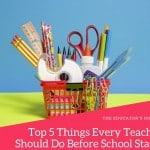Have you signed up for The Educator’s Room Daily Newsletter? Click here and support independent journalism!
During the first week of school, kindergarten teachers everywhere can be heard reading Miss Bindergarten Gets Ready for Kindergarten by Joseph Slate. Miss Bindergarten is a caring and notably hairy teacher with a passion for education and a wagging tail. Although the picture book includes personified animals teaching and driving school buses, the most incredible scene is actually the one featuring Miss Bindergarten’s classroom amenities. There are centers, or activity stations, around the room containing tools for a variety of activities. There is a toy kitchen complete with a tea set, an easel with paint supplies, blocks to build towers, miniature houses with figurines, a class library, and educational toy tubs. There is even a class pet! Why is this the most remarkable aspect of the book? Because kindergarten classrooms are rarely furnished like this anymore. Centers have become a thing of the past, and a rigorous, relentless curriculum has taken its place.
When I was in kindergarten twenty-something years ago, my favorite time of the day was centers. I dug through an indoor sandbox. I played house and pretended to cook, clean, and parent dolls (it’s worth noting that the boys participated in this center too). I built towers out of blocks. I drew pictures and scribbled stories. I don’t remember the math lessons or phonics, but I remember centers.
The Science Behind Centers
The idea behind centers is three-fold. First, all of the stations are educational. The sandbox is sensory. The blocks promote spatial recognition. The house teaches life skills such as cooking and cleaning. Art inspires creativity and utilizes fine motor skills. Centers are more than playtime and an opportunity for the teacher to drink her ice-cold coffee from earlier that morning. They are strategic educational stations that promote learning in a variety of ways.
Second, centers promote necessary life skills. During centers, students utilize and strengthen social skills. They learn to communicate and share. Clean-up time takes place at each station before students move to another one. During this time students learn to take responsibility for their toys and tools and to efficiently organize so they can quickly change to the next center. Changing stations every few minutes also promotes time management skills and independence as students adhere to the procedures and self-monitor their change of stations.
Finally, centers encourage movement in the classroom. The majority of the stations require students to stand, stretch, and walk around. This is a far cry from the modern classroom wherein students and teachers are tethered to their desks and hunched over computers.
Back to Basics
My kindergarten classroom looks a lot different as a teacher today than as a student years ago. Yes, my perspective has changed a lot in twenty years, but more than that, the standards, goals, and values of America’s education system have changed. I argue not for the better. Not only have activities like centers been removed from the classroom, but those activities have been replaced by a curriculum that is not developmentally appropriate for children.
Instead of short lessons and independent practice mixed with centers and a longer recess, kindergarten students now have a math lesson that is one and a half hours long. We require young students to write narratives and informational texts for 30 to 45 uninterrupted minutes. We expect them to read independently for 30 to 45 minutes. Their recess is only 20 minutes a day, and P.E. takes place only two days a week. Is it any wonder why so many children are acting out? Is it any wonder why I hear crying, screaming meltdowns echoing through the halls at least twice a day? The modern curriculum is not developmentally appropriate for children. In fact, it is detrimental to their physical and mental health.
How can we reverse this phenomenon? Parents, educators, and the community need to demand a change in the misguided standards, curriculum, and values of the American school system. We should not expect five-year-olds to sit quietly at a desk for seven hours a day. It’s time to get back to basics. Reinstate longer recesses and physical education more than once or twice a week. Reinstate developmentally appropriate curriculum and lesson lengths. Finally, reinstate centers and the creativity and age-appropriate educational value they provide.
Editor’s Note: If you enjoyed this article, please become a Patreon supporter by clicking here.






